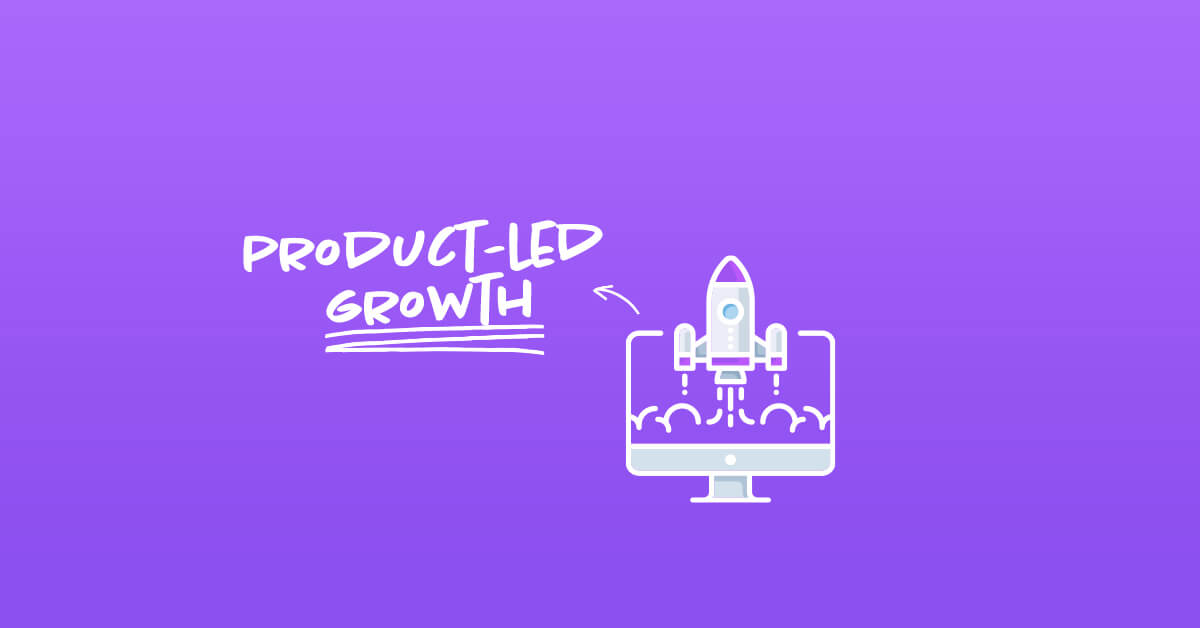Use product-led growth to reduce friction between the customer and the path to acquisition. Learn how to improve sales, cut off expenses and generate retention.
Your sales team has just got bigger, and it’s not because of new staff members. It’s the Product-led growth, or PLG, making your product become the seller itself!
Since customer experience is now mostly responsible for acquisition, buyers tend to prefer discovering value by themselves rather than having someone create scenarios for them.
Find out now how product-led growth and its fundamentals can be a powerful game changer for you.
What is Product-Led Growth?
Before diving deeper in this guide, you must have in mind that product-led growth creates a straight line connecting your customer and the acquisition moment, eliminating possible gutters and bumps throughout the way. PLG establishes a clear and smooth path towards value generation.
That said, this (not so brand) new business methodology allows customers to build their own product worth through customer experience (CX) instead of sales-leading them from Point A to Point B, like other business strategies.
By creating a truly meaningful experience, customers can now produce their own validation when it comes to the product. As a result, upgrades become a natural, no-brainer step of the way.
You build the experience focused on solving your end user’s pain. Now, your product has become the primary driver of acquisition.
The Importance of Product-Led Growth
Product-led growth is not just a business approach, a trend, or a marketing wave. PLG is an alignment between team strategies. It promotes a stronger integration, leading to a wiser, more polished and solid placement.
I bet you have seen this many times: sales and marketing operating so individually and distant from the product, they seem to be telling totally different stories.
Product-led growth tells: “Hey, marketing, your customer has just used Service X. How about triggering an upsell according to the interest flagged?”. Then, marketing can say: “Sales, here’s a hot opportunity for you to offer a personalized follow-up to this user”.
You create a cohesive storyline for everybody!
And you do that by offering real-life experience instead of just putting out their white papers telling how you can solve their pain. You are all focused on how your product can genarate demand.
Bill Macaitis, former CMO of Slack, says: “I tell my team members that their gold standard is not whether customers bought a product, but did they recommend us? It’s a higher bar and a different standard. We also don’t see marketing’s role as getting customers in the door and then wiping our hands and going on to the next one. Marketing’s role is about recommendation”.
Through PLG, every single collaborator has its focus on product, enduring and enhancing customer value. The demands are real, folks! They need to try before they buy.
Product-Led Growth Background
These definitions presented so far might seem pretty disruptive and innovative, but it’s not, actually. In fact, PLG is a result of the constant development of strong product-based companies.
The name Product-Led Growth gained visibility around 2017 when OpenView Partners brought up some discussions that created some of the guidelines fostered until these days. But it actually started at the beginning of the last decade.
Here goes a brief contextualization of Growth eras we’ll explore appropriately ahead.
Product-led growth puts all divisions of a company running on the same track. But before it happened, Sales-led growth (SLG) was the one in charge for most of the strategies.
That means field sales, high-touches and a dramatic amount of money spent on customer acquisition were considered top priorities.
Then, as the way customer experience improved and Marketing-led growth (MLG) took the spot for a while. MLG brought the idea of inbound marketing along with the purpose of reducing customer cost acquisition.
But since 2017, Product-led growth has constantly proven that the efforts must be pointed, like a prism effect, towards one thing: the product itself.
Take Dropbox as an example. A decade ago, they were using the product to generate leads and drive business –– even if there was no such thing as “product-led growth” yet.
Dropbox
It has been said earlier that product-led growth is not as brand new as it seems. There were a few pioneers in PLG, such as Slack, Mailchimp, Typeform and, the one to talk about, Dropbox.
Dropbox is one of the best examples to understand PLG on a regular basis and to actually see the benefits. In less than 10 years, they have reached $1bi in revenue!
They started as this simple, initially free, but with pretty interesting features storage platform. Dropbox rapidly became one of the best tools for file sharing, going viral worldwide.
To take advantage of the massive visibility, they gave the user a possibility to earn more space by sharing a referral link. As a result, they got thousands of new users and enhanced the experience of those existing ones.
The community had so much value there, Dropbox became an essential part of users’ lives. The upgrade to a paid version was just a matter of time. It was organic. No friction is needed.
Netflix
Let’s take Netflix as an example now: an excellent model of a company conscious of digital changes, aware it was not a matter of “if” they had to innovate, but “when”.
They have been in the business for quite a while now, and we can have some great tips on their product-led growth.
When you first met their streaming platform and signed up for a free month trial, no sales rep had you on the phone or flooded your inboxes with probably annoying messages trying to convince you why you should have the paid version.
Instead, Netflix opened up its entire catalog for you. No restrictions, no limits, just the complete experience there for you to taste!
During the free month trial, as you binge-watch their shows, they kept “magically” suggesting more content related to your preferences. And that was definitely not a random thing.
Netflix’s PLD reads all your interests and builds an entire scenario exclusively for you. Your experience was enhanced by data they collected from your behavior, like DNA.
And that’s exactly what product-led growth also can do for your company. It turns your product into a powerful source of primary acquisition.
Why should you use a Product-Led Growth Strategy?
In a progressively expanding market, product-led growth shows you don’t need to overspend in advertising costs, new team members or any other decision that might become a trap due to desperation to achieve better results.
It also reveals where you actually need to invest money, time and effort. Through PLG you’ll see it’s needed to redefine design paradigms and explore new demands when it comes to product thinking.
From now on, products must be self-sufficient! Customers want to self-educate themselves more than ever. They want to build their own way to experience products. That leads to a hands-on moment, and that is when “try before you buy” comes into the scene.
The Evolution of Growth Acquisition Strategy (GAS)
An action plan to acquire, retain and grow customers are the fundamentals of a Growth Acquisition Strategy. Those pillars enable a better definition of product distribution and the most appropriate channel to do it.
Definitely not a strategy to be set and forget, PLG requires a collective alignment to break team walls and synchronize the moves.
We had briefly mentioned before the eras, but now it’s time to dig in. Keep up!
1st Era: Sales-led Growth
The main difference between Sales-led and Product-led growth is how the first one had its focus on cold-emailing and calling, outreach and sales lead scoring based on aspects like the industry, titles, teams’ sizes, etc. Back then, it had nothing to do with the product itself nor the experience.
Sales-led qualification didn’t try to actually prove any value. Instead, they were 100% committed to convincing the customer about their product by simply telling. Buyers didn’t have tangible proof of the benefits.
It’s also important to mention the Customer Acquisition Cost (CAC) during sales-led growth times since the entire onboarding had to be procedure by the seller itself, customer by customer.
That approach could be long, tiring and really expensive. The purchase had to cover all those expenses out, or else all the work and effort wouldn’t pay off.
2nd Era: Marketing-led Growth
With the advance of the internet, consumers were able to get more information for themselves during the buyer’s journey. That empowered them to be much more in control of the process.
The primary driver of acquisition here was to obtain leads and nourish them. That’s what we call Marketing-led growth (MLG).
Marketing-led taught consumers about self-education, generating qualified demands. As a result, you had a Marketing Qualified Lead (MQL). Inbound marketing was the pivot to build MQL, have scaled demand and give the chop to high customer acquisition costs.
It also had a medium/low-touch approach, opening room for more polished and personalized conversion methods. Sales now became an inside operation, having their role placed mostly at the end of the funnel.
Looks like a great change compared to the previous growth model, right? But MLG had some death traps that frequently led to a high rate of unclosed deals. According to ProductLed, these were the top 3 reasons conversions became a serious issue:
- It encourages marketers to gate content to hit their MQL goals.
- It focuses on content consumption as a leading indicator of intent.
- The entire process rewards creating friction in the buying process.
The result was a major disconnection between marketing and sales. This business model segregated profit centers and costs centers, creating a weak organizational ground.
Product-Led Growth Taking Over Tech Companies
Understanding and embracing product-led behavior is key. The End User Era is real, and so are new demands. But a turning point here is to take a step aside and analyze how this can be applicable to you and your reality.
It’s not about becoming Dropbox, HubSpot or anything else. Of course, it’s totally fair to emulate their steps and get inspirational, but your successful story can be authentic to your story.
Small, medium and big technology companies, across all product categories, realized that product-led growth is much more than a disruptive strategy. The way people use and buy your software has changed, and so has your go-to-market playbook.
B2C Product-Led Growth Companies
Business-to-Customer (B2C) companies on their way to a strategy rely on the product as the primary driver for acquisition need to remember one thing: their end customer is a real person, and the need to build a personalized experience based on that rule is crucial.
Most of those end users don’t want to go through a lengthy sales process to find out if there’s a fit or not to the product. They want to try it now, selecting their own criteria to make the pavement towards a unique experience and satisfaction.
A report from Forester found that nearly 75% of B2B buyers rather buy through an app or website than having a salesperson guidance. That’s because 80% of people tend to do business with companies that offer personalization.
And that is why the following names became heavy players when it comes to B2C companies on product-led growth, according to ProductLed.
It’s curated feed, personalized user onboarding, and inherent virality make Pinterest a poster child for product-led growth—and in 2019, IPO’d with a $12.7 billion valuation.
Typeform
Launched in 2013 as a free beta, its conversational approach to data collection and beautiful, easy-to-use form builder helped Typeform go viral. They closed a $35 million Series B in 2017.
Warby Parker
The digital-first eyewear retailer raised a $75 million Series E in 2019, thanks in part to its omnichannel consumer experience and free Home Try-On program (aka free trial).
B2B Product-Led Growth Companies
Your Business-To-Business (B2B) message needs to be communicated not just to executive users but to end users as well. Rethink the design of your website. Ask yourself: “Am I making the sign-up stage the easiest process here?”
Make your product become your marketing channel, enabling chances to virality through referral paths and user reviews. ProductLed also highlighted how these groundbreaking B2B companies helped their consumer realize fast the value of their products
Airtable
Reported $20 million in revenue in 2018 and created Airtable Universe to scale the inspiration of use cases, a responsibility usually held by customer success.
Slack
43% of the Fortune 100 pay for Slack and are loud advocates because of their company-wide devotion to its great experience.
Figma
Closed a $40 million Series C in 2019 thanks to its product-led approach to solving designer pain points like project organization, file management, and real-time collaboration.
Product-Led Growth as a Market Entry Strategy
It’s important to acknowledge the existence of buyers who rely on sales support. They need more when it comes to making their decision. It might be a complex process, but there lies a precious opportunity to collect data, enhance lead qualification and improve the chances of conversion.
Follow your prospect’s steps: understand what they are using, where, what part they’re getting caught up. With this quality of information, your support can touch precisely their pain point and offer the greatest solution.
That is a masterful way to create a personalized customer experience!
Product-Led Growth Key Metrics and Principles
We mentioned earlier about team alignment. Check it out how it really works on a daily basis. It is very important to create homogenous communication. The bond of this integration is common language and reporting system.
What are PLG Metrics?
For your surprise, you might have been tracking some of the product-led growth metrics. Many used in SaaS metrics are very helpful to PLG. Although, they have different levels of relevance in a scenario ruled by product-led growth approaches.
How to Measure Product-Led Growth
Before we start listing just a few of them, it’s important to emphasize that each metric below can be leveraged differently by your teams. Carefully analyze how they fit for you and use them as a customizable framework.
Time to Value (TTV)
This one measures how long it takes your customer to realize your product’s value. The goal here is to reduce this time and make users feel that “aha!” moment as soon as possible.
TTV is also used to understand how much time users spend from acquisition to activation.
To do this, you must focus on the onboarding experience around the key actions correlated to activation: invites, referrals, data sharing, integration, etc.
Expansion revenue
Here, you’ll measure revenue from existing customers due to upsells, cross-sells, add-ons, etc.
The market commonly sees expansion revenue as a new acquisition strategy. Although, the best players in business recommend that at least 30% of your revenue should come from there.
Product-Qualified Leads (PQLs)
The leads right here are those who’ve already experienced your product, had the “aha!” moment and already know its value from a free trial of a freemium account.
To define this metric you need to create some events to track if they’re ready to move on to the next stage. These events could be related to usability, sections visited, or previously defined behaviors that flag an opportunity.
Customer Lifetime Value (CLV)
Now that you know how long it takes for your consumer to realize your product’s value, the events accomplished to prove they’re ready to acquire, now is time to understand how much revenue your business receives from a single customer throughout this relationship.
CLV is one of the most accurate, high-level indicators to show business health. To calculate it, you must divide the total expansion revenue by the number of customers.
The Benefits of Product-Led Growth
Through a low-touch/touch-free approach, frictionless customer acquisition, team alignment, synchronicity, and so many others, there’s only one thing expected from all this heavy work: money!
The power of product-led growth leads to financial productivity – a higher revenue per employee. And that is possible because of the product driving force during acquisition, engagement, retention and expansion.
As the product itself does much of the marketing, sales and customer experience work in a PLG strategy, a massive cut in customer acquisition cost and shorter sales cycles.
In addition, a higher revenue diversity comes up as a strong suit for PLG, minimizing the consequences of losing accounts and enhancing growth.
Wes Bush, a renowned PLG pioneer, says that “product-led businesses tend to scale faster than their competitors in two powerful ways”:
- Wider top-of-funnel: A free trial or freemium model opens up your funnel to people earlier in the customer journey. This is powerful because, instead of prospects filling out your competitor’s demo requests, they’re evaluating your product;
- Rapid global scale: While your competitors are busy hiring new sales reps for each region under the sun, you can focus on improving your onboarding process to service more customers around the world in a fraction of the time.
Product-led growth has proven over the years its power to be financially productive and operates to leverage data produced by-products to improve sales. Us from Arena wants to help you get there on product-led growth. And it’s going to be right now!




